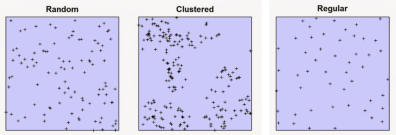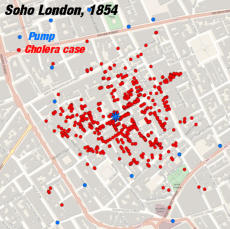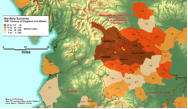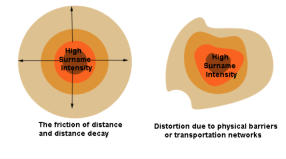Distributions:
A distribution refers to the way things are arranged in a geographic space. The concept can be
applied to nearly anything on earth, from animals, to disease infections, climate, and in this case
surnames.
Patterns:
Spatial distributions generally
fall into one of two broad
categories, random or non
random. Geographers are not
concerned with random
distributions which by definition
are caused by chance. On the
other hand non random
distributions are influenced by factors that impact the distribution resulting in patterns which are of
interest to the geographer.
Uniform Distributions:
Many geographic distributions are uniform in nature. Villages are distributed uniformly across the
landscape in order to best serve the population. Larger urban centres will be less frequent but will
develop at locations where they are accessible to a regions population. Schools or public services
in urban areas tend to be located conveniently for their customers and consequently exhibit spatial
uniformity.
Clustered Distributions:
A clustered distribution is one which is concentrated within a localized area. Examples could range
from crime hotspots to disease clusters. Many surnames distributions exhibit this characteristic.
The geographer seeks to identify the underlying causal factor(s) that shape the pattern.
Distance Decay and the Friction of Distance:
Clustered distributions generally exhibit a core where the
frequency is highest and which diminishes in intensity as
distance from the core increases. In the summer of 1854 an
outbreak of Cholera occurred in London England. At the
time the cause of Cholera was not known and competing
theories were hotly debated. While sanitation was
suspected, the direct link with drinking water was not
considered. Dr. John Snow who practised in the area
observed that the incidence of Cholera was highest in the
area immediately around the Broad Street pump. With
increasing distance from the pump the frequency of cholera
cases diminished, a classic example of distance decay and
the friction of distance. Snow was unable to convince the
Board of Health of his theory. In an act of desperation and
frustration he had the pump handle removed and shortly thereafter the outbreak subsided.
Surnames distributions often express the friction of
distance and distance decay. For example family
ties, economic and biological factors, can often lead
to the ramification of surnames at specific points.
Over time individuals will migrate from their point of
origin resulting in the diffusion of a surname. The
surname may also drift from it’s point of origin. This
can often observed with surnames derived from place
names or topographic features.
Geographic Persistence:
The Hardisty surname is derived from an English place name. From A Dictionary of Surnames
(Hanks and Hodges), we learn that Hardisty;
is a habitation name from a place in Yorks., in the parish
of Fewston. The place name is recorded in 1379 as
Hardolfsty, from the Old English personal name Heardwulf
(composed of the elements heard hardy, brave, strong +
wulf wolf) + Old English stïg path).
In addition to distance decay and the friction of distance, the Hardisty surname demonstrates the
tendency of many surnames to remain persistent within the geographic region where they were
formed. In Little Timble, Great Timble & the Hamlet of Snowden by William Grainge (1895), we are
told that;
Hardisty or Hardistie – is one of the family names that appear to have sprung up on the
Forest soil, flourished through all the period of recorded time, and is yet remaining in the
land”.
The themes of distance decay, the friction of distance, and geographic persistence, are recurring
themes and are central to understanding the geography of surnames.



© J.H.Mathieson

















